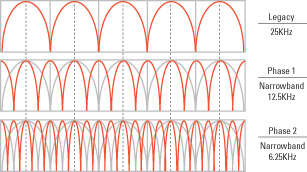Narrowbanding
The FCC
Narrowbanding Mandate:
What You Need to Know to Assure
Radio Communications in 2013
What is
Narrowbanding?
Private land mobile radio (LMR) systems - including municipal government and State and local public safety systems - use blocks of radio spectrum called channels. Historically, LMR systems have used 25 kHz-wide channels. In December 2004, the Federal Communications Commission mandated that all private LMR users operating below 512 MHz move to 12.5 kHz narrowband voice channels and highly efficient data channel operations by January 1, 2013. This migration complements a National Telecommunications and Information Administration mandate for more rapid Federal agency migration to 12.5 kHz narrowband operation by January 1, 2008. The earlier Federal deadline affects State and local FCC licensees that interface or share frequencies with Federal radio systems.
Using narrowband channels will ensure that agencies take advantage of more efficient technology and, by reducing channel width, will allow additional channels to exist within the same spectrum space, as illustrated in figure 1
Figure 1:
Narrowband channels allow additional channels to exist in the same
spectrum.
Who is Affected:
The FCC Narrowbanding rules affect all operators of land mobile radios (LMR) that use channels between:
- 150 and 174 MHz
- 421 and 512 MHz
Deadlines / Key Dates:
To phase in the migration deadline of January 1, 2013, the FCC has established interim deadlines.
The first important deadline is January 1, 2011 (Manufacturer Date Certain) after which:
- The FCC will not grant applications for new voice operations or applications to expand the authorized contour of existing stations that use 25 kHz channels. Only narrowband authorizations will be granted.
- The FCC will prohibit manufacture or importation of new equipment that operates on 25 kHz channels. This will reduce the availability of new equipment for legacy radio systems and will affect how agencies maintain and upgrade older systems.
- New equipment submitted for FCC type-acceptance must be 6.25/6.25 kHz (e)
- New system applications must be 12.5 kHz or less
- No 25 kHz system expansion permitted
January 1, 2013 (Licensee Date Certain)
- All existing licenses must operate on channels with a bandwidth of 12.5 KHz or less (narrowband). Failure to comply with the January 1, 2013 deadline results in cancellation of license.
- I/B and PS 150-512 MHz incumbents must migrate to 12.5/12.5 kHz (e) or less
- It is unclear what happens to licensed 25 kHz systems after this date certain
Land Mobile Radio Systems still using wideband channels as of January 1, 2013, risk the following:
- Loss of Radio Communications
- Substantial FCC Fines
- Revocation of FCC Licenses
Planning for the Move to Narrowband
Land Mobile Radio System Operators (both public safety and nonpublic safety) need to aggressively develop a strategy to meet narrowband deadlines to avoid cancellation of existing wideband FCC authorizations. Although the migration deadline may seem far off, the long lead time and interim deadlines make it necessary for you to plan well in advance.
Assess Current Equipment and Start Planning.
To prepare for the migration, organizations should start assessing their radio systems and planning for replacements or upgrades. They should inventory their current equipment to ascertain what can be converted to 12.5 kHz and what will need to be replaced before January 1, 2013. Most new equipment has the capability for both 25 kHz and 12.5 kHz operation because any VHF/UHF radio equipment accepted by the FCC after February 14, 1997, had to have 12.5 kHz capability. 12.5 kHz narrowband equipment is available in both conventional analog FM and digital formats (such as Project 25), so narrowband conventional FM systems will be compliant. Local governments should develop contingency plans to accommodate system changes for both public safety and non public safety systems.
Obtain New or Modified Licenses.
To move to narrowband operations, organizations must apply for new frequencies or modify existing licenses. An organization that is licensed for a 25 kHz-wide channel is not guaranteed two 12.5 kHz channels. Licensees will have to justify to the FCC why they need additional channels. Consideration of applications for new narrowband licenses will follow the same process as a new license application. As organizations migrate to narrowband operation, however, the pool of available frequencies will increase.
For More Answers
View FCC Document, 03-34,
February 25, 2003 .
View the FCC revisions,
FCC Document 04-292A1, December 23, 2004
Q - Are we forced to move to 700 MHz or 800 MHz?
A - No. Narrowbanding does not require moving to another frequency band.
Q - Will we have to buy new radios?
A - Depends. Most radios purchased in the last 6-8 years are already narrowband capable. They only need to be re-tuned.
Q – Will we need to change frequencies?
A – No. You merely reduce the bandwidth of the channel(s) you are now using.
Q – Will that reduce our coverage?
A – Little if any. You may have to survey your system and area of operation. Only a thorough analysis of your coverage requirements can tell for sure.
Q – Will we have to convert to digital?
A– No. However, many agencies are using this opportunity to upgrade to digital technology. Most digital radios are dual mode capable and can operate in wide band analog as well as narrowband analog and digital. Digital is also more immune from adjacent channel interference along with features unavailable in analog.
Q – We do not have the money to move to narrowband. Isn’t this an unfunded mandate?
A– Not really. The dates are extended enough to ensure most agencies have fully amortized the value of their current equipment by the time the mandates kick in.
Q - We have a data system. Won't this reduce our throughput?
A - Data systems must meet the 4800
bps/6.25 kHz equivalency. If your current 25 kHz system sustains
19.2 Kbs at 25 kHz, you may continue to use it and expand
coverage area.
back to top

